Evaluating a Depression Brochure
VerifiedAdded on 2020/04/21
|7
|1403
|36
AI Summary
This assignment involves critically analyzing a brochure designed to educate patients about depression. The evaluation focuses on the clarity of information presented, alignment with current nursing and healthcare research, target audience, and the potential impact of the brochure on patient safety. Specific criteria include outlining how well the information is presented, verifying its accuracy based on research, identifying the intended beneficiaries, and explaining how the brochure can contribute to safer patient care.
Contribute Materials
Your contribution can guide someone’s learning journey. Share your
documents today.
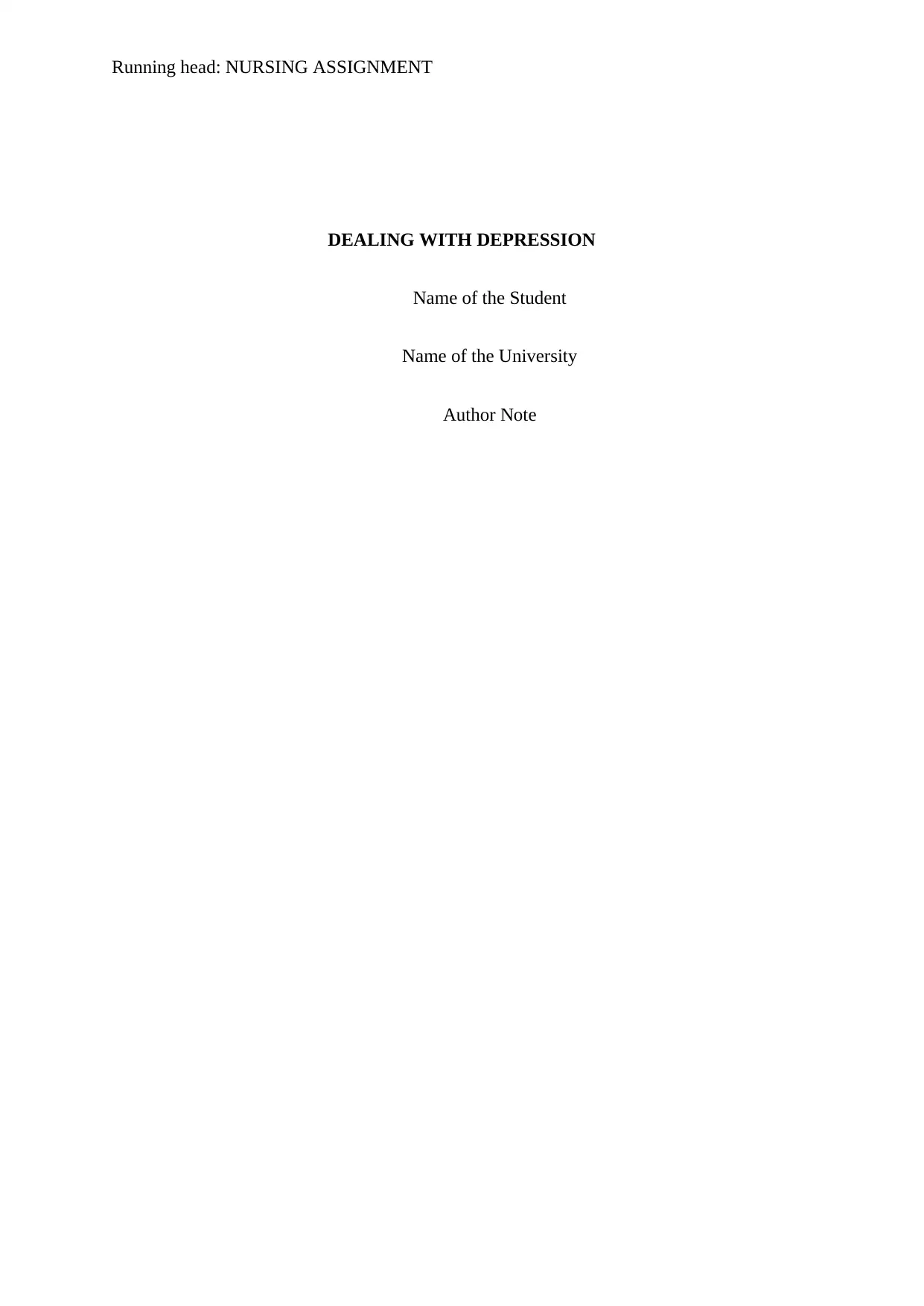
Running head: NURSING ASSIGNMENT
DEALING WITH DEPRESSION
Name of the Student
Name of the University
Author Note
DEALING WITH DEPRESSION
Name of the Student
Name of the University
Author Note
Secure Best Marks with AI Grader
Need help grading? Try our AI Grader for instant feedback on your assignments.
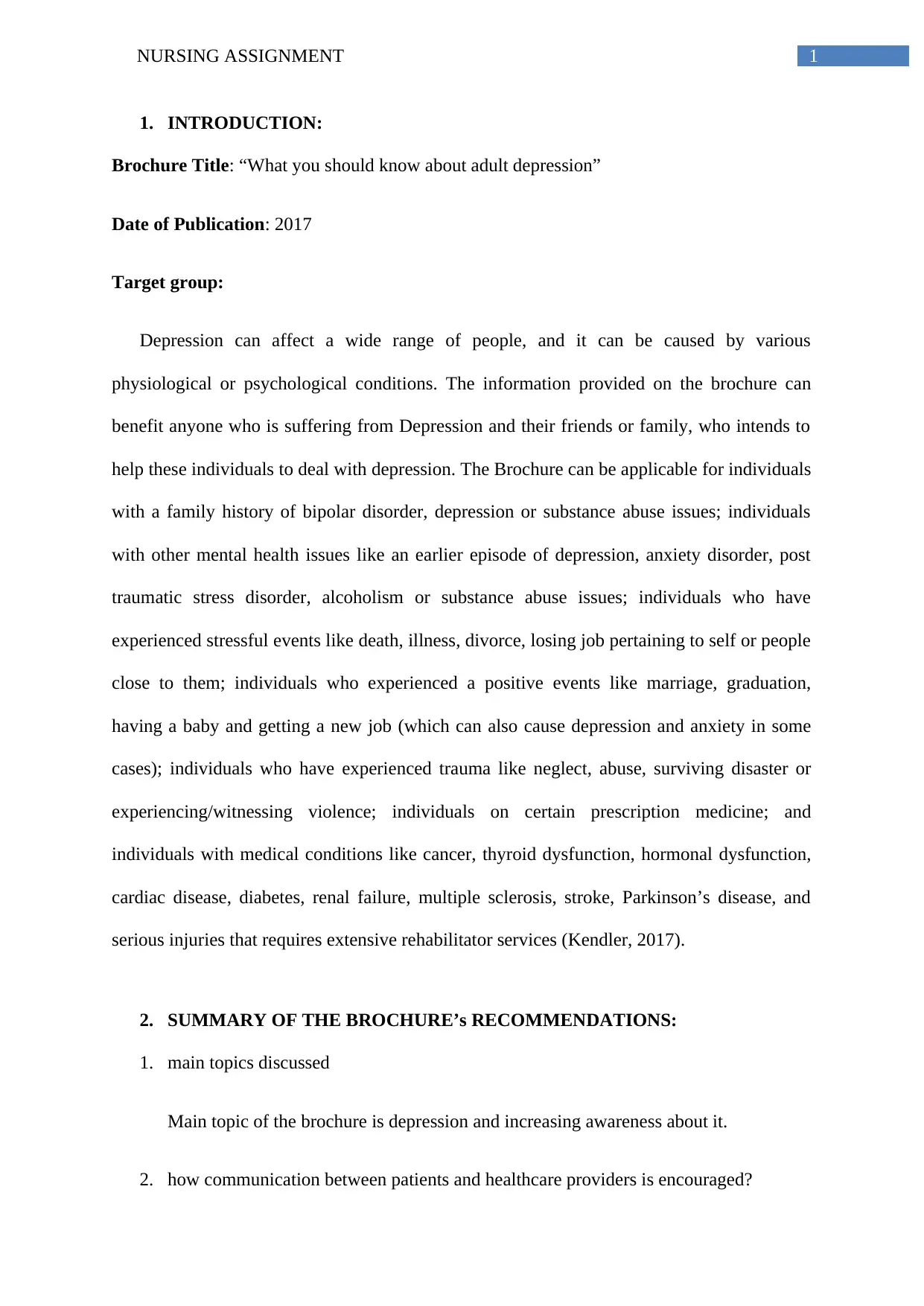
1NURSING ASSIGNMENT
1. INTRODUCTION:
Brochure Title: “What you should know about adult depression”
Date of Publication: 2017
Target group:
Depression can affect a wide range of people, and it can be caused by various
physiological or psychological conditions. The information provided on the brochure can
benefit anyone who is suffering from Depression and their friends or family, who intends to
help these individuals to deal with depression. The Brochure can be applicable for individuals
with a family history of bipolar disorder, depression or substance abuse issues; individuals
with other mental health issues like an earlier episode of depression, anxiety disorder, post
traumatic stress disorder, alcoholism or substance abuse issues; individuals who have
experienced stressful events like death, illness, divorce, losing job pertaining to self or people
close to them; individuals who experienced a positive events like marriage, graduation,
having a baby and getting a new job (which can also cause depression and anxiety in some
cases); individuals who have experienced trauma like neglect, abuse, surviving disaster or
experiencing/witnessing violence; individuals on certain prescription medicine; and
individuals with medical conditions like cancer, thyroid dysfunction, hormonal dysfunction,
cardiac disease, diabetes, renal failure, multiple sclerosis, stroke, Parkinson’s disease, and
serious injuries that requires extensive rehabilitator services (Kendler, 2017).
2. SUMMARY OF THE BROCHURE’s RECOMMENDATIONS:
1. main topics discussed
Main topic of the brochure is depression and increasing awareness about it.
2. how communication between patients and healthcare providers is encouraged?
1. INTRODUCTION:
Brochure Title: “What you should know about adult depression”
Date of Publication: 2017
Target group:
Depression can affect a wide range of people, and it can be caused by various
physiological or psychological conditions. The information provided on the brochure can
benefit anyone who is suffering from Depression and their friends or family, who intends to
help these individuals to deal with depression. The Brochure can be applicable for individuals
with a family history of bipolar disorder, depression or substance abuse issues; individuals
with other mental health issues like an earlier episode of depression, anxiety disorder, post
traumatic stress disorder, alcoholism or substance abuse issues; individuals who have
experienced stressful events like death, illness, divorce, losing job pertaining to self or people
close to them; individuals who experienced a positive events like marriage, graduation,
having a baby and getting a new job (which can also cause depression and anxiety in some
cases); individuals who have experienced trauma like neglect, abuse, surviving disaster or
experiencing/witnessing violence; individuals on certain prescription medicine; and
individuals with medical conditions like cancer, thyroid dysfunction, hormonal dysfunction,
cardiac disease, diabetes, renal failure, multiple sclerosis, stroke, Parkinson’s disease, and
serious injuries that requires extensive rehabilitator services (Kendler, 2017).
2. SUMMARY OF THE BROCHURE’s RECOMMENDATIONS:
1. main topics discussed
Main topic of the brochure is depression and increasing awareness about it.
2. how communication between patients and healthcare providers is encouraged?
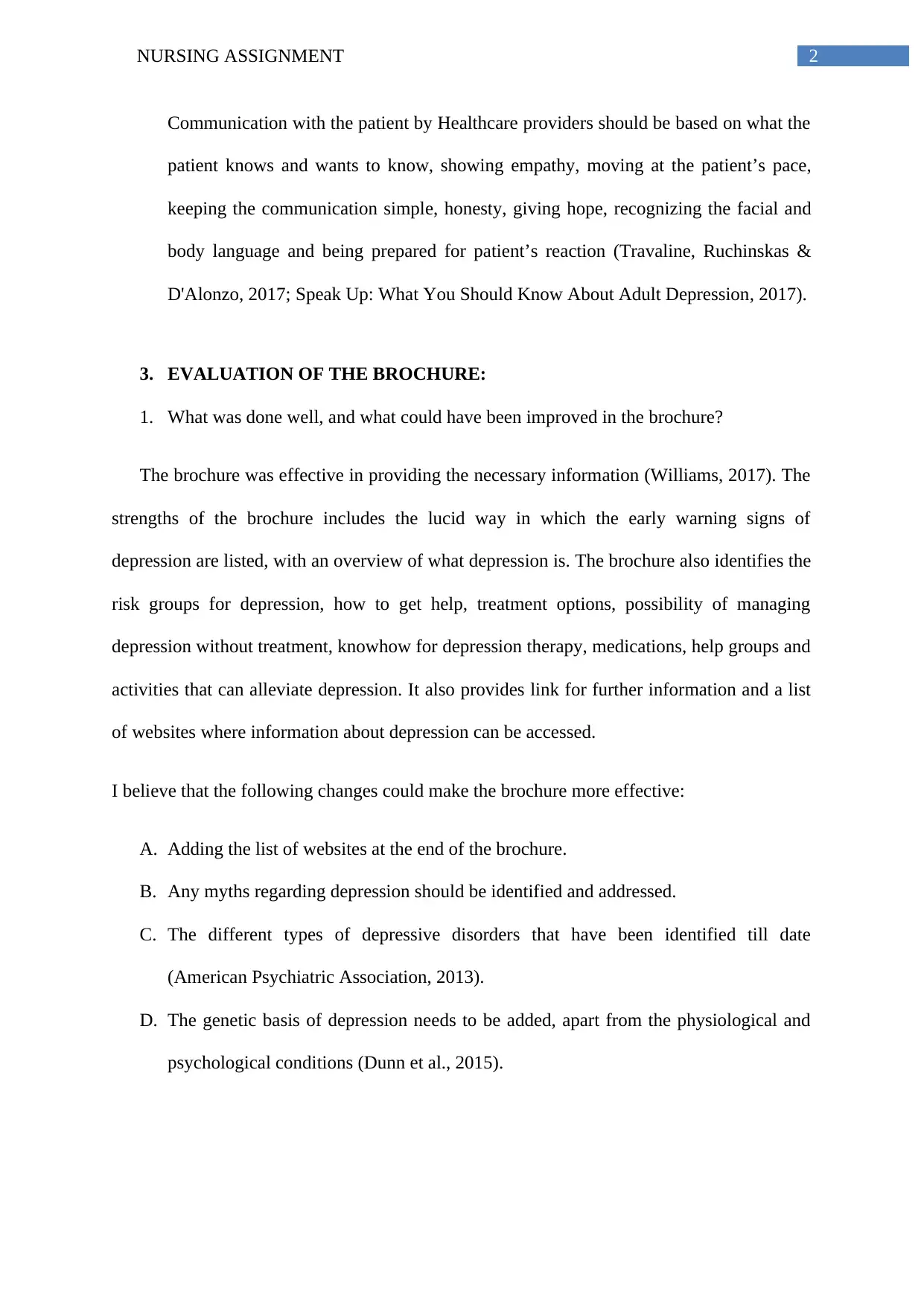
2NURSING ASSIGNMENT
Communication with the patient by Healthcare providers should be based on what the
patient knows and wants to know, showing empathy, moving at the patient’s pace,
keeping the communication simple, honesty, giving hope, recognizing the facial and
body language and being prepared for patient’s reaction (Travaline, Ruchinskas &
D'Alonzo, 2017; Speak Up: What You Should Know About Adult Depression, 2017).
3. EVALUATION OF THE BROCHURE:
1. What was done well, and what could have been improved in the brochure?
The brochure was effective in providing the necessary information (Williams, 2017). The
strengths of the brochure includes the lucid way in which the early warning signs of
depression are listed, with an overview of what depression is. The brochure also identifies the
risk groups for depression, how to get help, treatment options, possibility of managing
depression without treatment, knowhow for depression therapy, medications, help groups and
activities that can alleviate depression. It also provides link for further information and a list
of websites where information about depression can be accessed.
I believe that the following changes could make the brochure more effective:
A. Adding the list of websites at the end of the brochure.
B. Any myths regarding depression should be identified and addressed.
C. The different types of depressive disorders that have been identified till date
(American Psychiatric Association, 2013).
D. The genetic basis of depression needs to be added, apart from the physiological and
psychological conditions (Dunn et al., 2015).
Communication with the patient by Healthcare providers should be based on what the
patient knows and wants to know, showing empathy, moving at the patient’s pace,
keeping the communication simple, honesty, giving hope, recognizing the facial and
body language and being prepared for patient’s reaction (Travaline, Ruchinskas &
D'Alonzo, 2017; Speak Up: What You Should Know About Adult Depression, 2017).
3. EVALUATION OF THE BROCHURE:
1. What was done well, and what could have been improved in the brochure?
The brochure was effective in providing the necessary information (Williams, 2017). The
strengths of the brochure includes the lucid way in which the early warning signs of
depression are listed, with an overview of what depression is. The brochure also identifies the
risk groups for depression, how to get help, treatment options, possibility of managing
depression without treatment, knowhow for depression therapy, medications, help groups and
activities that can alleviate depression. It also provides link for further information and a list
of websites where information about depression can be accessed.
I believe that the following changes could make the brochure more effective:
A. Adding the list of websites at the end of the brochure.
B. Any myths regarding depression should be identified and addressed.
C. The different types of depressive disorders that have been identified till date
(American Psychiatric Association, 2013).
D. The genetic basis of depression needs to be added, apart from the physiological and
psychological conditions (Dunn et al., 2015).
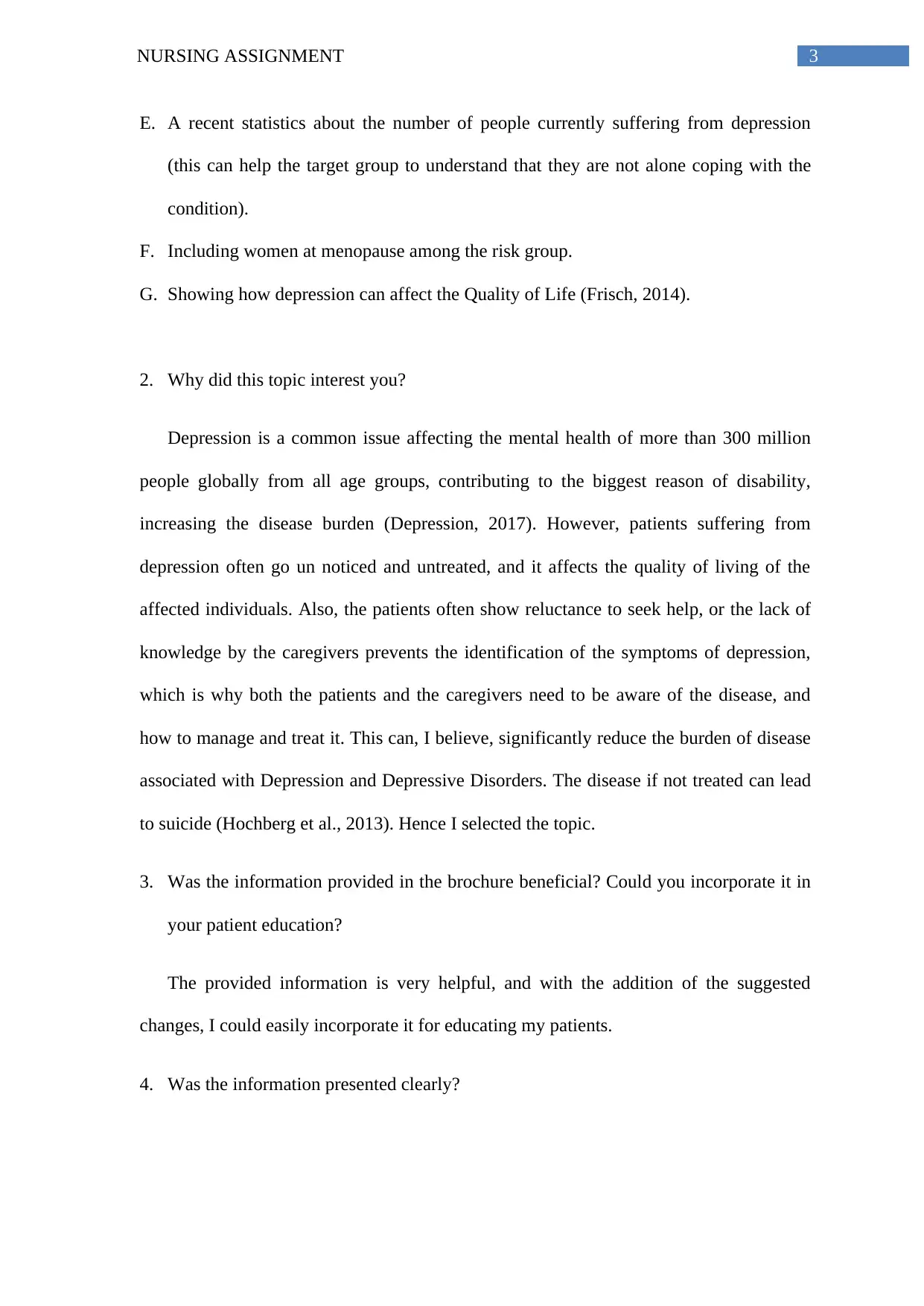
3NURSING ASSIGNMENT
E. A recent statistics about the number of people currently suffering from depression
(this can help the target group to understand that they are not alone coping with the
condition).
F. Including women at menopause among the risk group.
G. Showing how depression can affect the Quality of Life (Frisch, 2014).
2. Why did this topic interest you?
Depression is a common issue affecting the mental health of more than 300 million
people globally from all age groups, contributing to the biggest reason of disability,
increasing the disease burden (Depression, 2017). However, patients suffering from
depression often go un noticed and untreated, and it affects the quality of living of the
affected individuals. Also, the patients often show reluctance to seek help, or the lack of
knowledge by the caregivers prevents the identification of the symptoms of depression,
which is why both the patients and the caregivers need to be aware of the disease, and
how to manage and treat it. This can, I believe, significantly reduce the burden of disease
associated with Depression and Depressive Disorders. The disease if not treated can lead
to suicide (Hochberg et al., 2013). Hence I selected the topic.
3. Was the information provided in the brochure beneficial? Could you incorporate it in
your patient education?
The provided information is very helpful, and with the addition of the suggested
changes, I could easily incorporate it for educating my patients.
4. Was the information presented clearly?
E. A recent statistics about the number of people currently suffering from depression
(this can help the target group to understand that they are not alone coping with the
condition).
F. Including women at menopause among the risk group.
G. Showing how depression can affect the Quality of Life (Frisch, 2014).
2. Why did this topic interest you?
Depression is a common issue affecting the mental health of more than 300 million
people globally from all age groups, contributing to the biggest reason of disability,
increasing the disease burden (Depression, 2017). However, patients suffering from
depression often go un noticed and untreated, and it affects the quality of living of the
affected individuals. Also, the patients often show reluctance to seek help, or the lack of
knowledge by the caregivers prevents the identification of the symptoms of depression,
which is why both the patients and the caregivers need to be aware of the disease, and
how to manage and treat it. This can, I believe, significantly reduce the burden of disease
associated with Depression and Depressive Disorders. The disease if not treated can lead
to suicide (Hochberg et al., 2013). Hence I selected the topic.
3. Was the information provided in the brochure beneficial? Could you incorporate it in
your patient education?
The provided information is very helpful, and with the addition of the suggested
changes, I could easily incorporate it for educating my patients.
4. Was the information presented clearly?
Secure Best Marks with AI Grader
Need help grading? Try our AI Grader for instant feedback on your assignments.
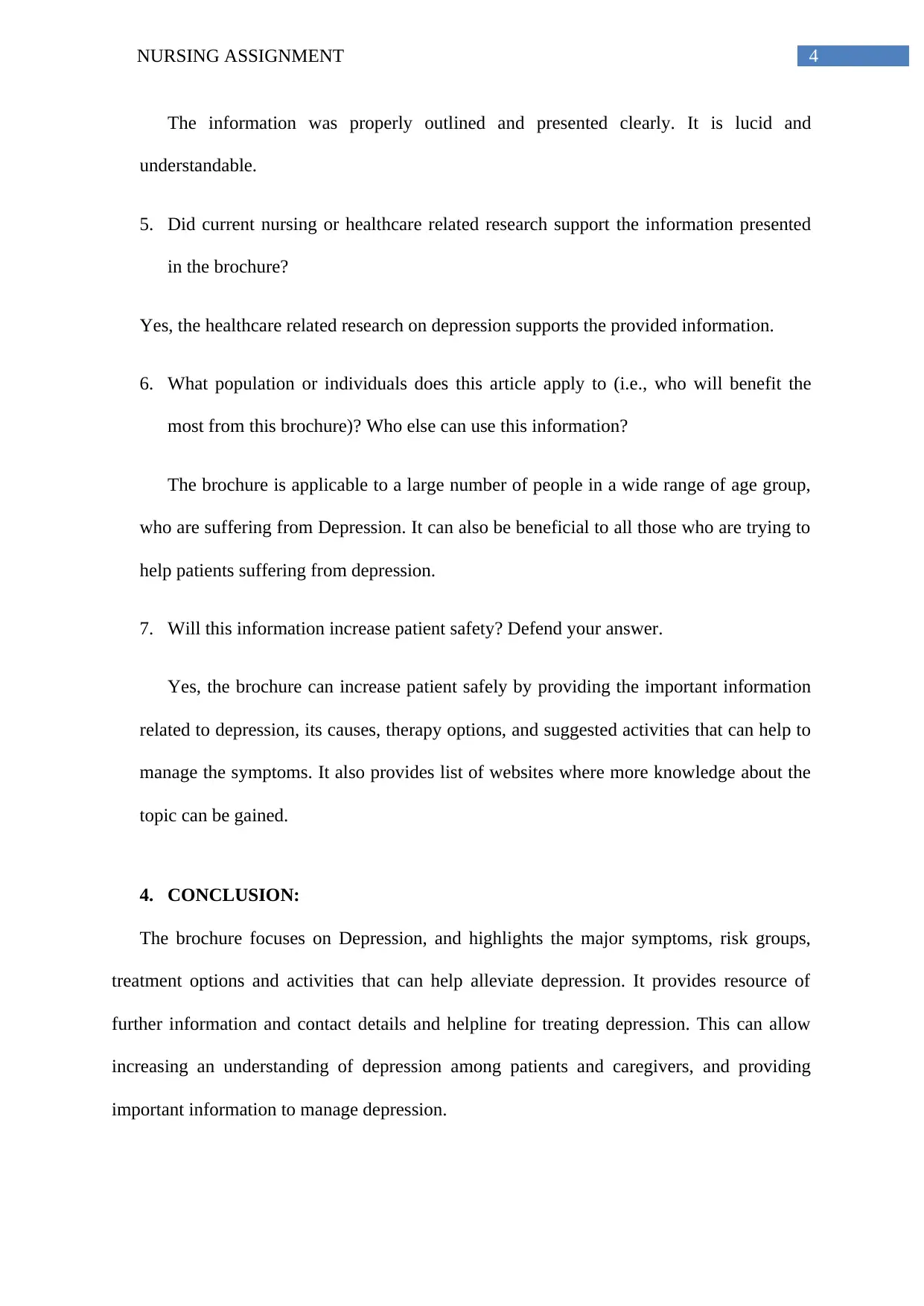
4NURSING ASSIGNMENT
The information was properly outlined and presented clearly. It is lucid and
understandable.
5. Did current nursing or healthcare related research support the information presented
in the brochure?
Yes, the healthcare related research on depression supports the provided information.
6. What population or individuals does this article apply to (i.e., who will benefit the
most from this brochure)? Who else can use this information?
The brochure is applicable to a large number of people in a wide range of age group,
who are suffering from Depression. It can also be beneficial to all those who are trying to
help patients suffering from depression.
7. Will this information increase patient safety? Defend your answer.
Yes, the brochure can increase patient safely by providing the important information
related to depression, its causes, therapy options, and suggested activities that can help to
manage the symptoms. It also provides list of websites where more knowledge about the
topic can be gained.
4. CONCLUSION:
The brochure focuses on Depression, and highlights the major symptoms, risk groups,
treatment options and activities that can help alleviate depression. It provides resource of
further information and contact details and helpline for treating depression. This can allow
increasing an understanding of depression among patients and caregivers, and providing
important information to manage depression.
The information was properly outlined and presented clearly. It is lucid and
understandable.
5. Did current nursing or healthcare related research support the information presented
in the brochure?
Yes, the healthcare related research on depression supports the provided information.
6. What population or individuals does this article apply to (i.e., who will benefit the
most from this brochure)? Who else can use this information?
The brochure is applicable to a large number of people in a wide range of age group,
who are suffering from Depression. It can also be beneficial to all those who are trying to
help patients suffering from depression.
7. Will this information increase patient safety? Defend your answer.
Yes, the brochure can increase patient safely by providing the important information
related to depression, its causes, therapy options, and suggested activities that can help to
manage the symptoms. It also provides list of websites where more knowledge about the
topic can be gained.
4. CONCLUSION:
The brochure focuses on Depression, and highlights the major symptoms, risk groups,
treatment options and activities that can help alleviate depression. It provides resource of
further information and contact details and helpline for treating depression. This can allow
increasing an understanding of depression among patients and caregivers, and providing
important information to manage depression.
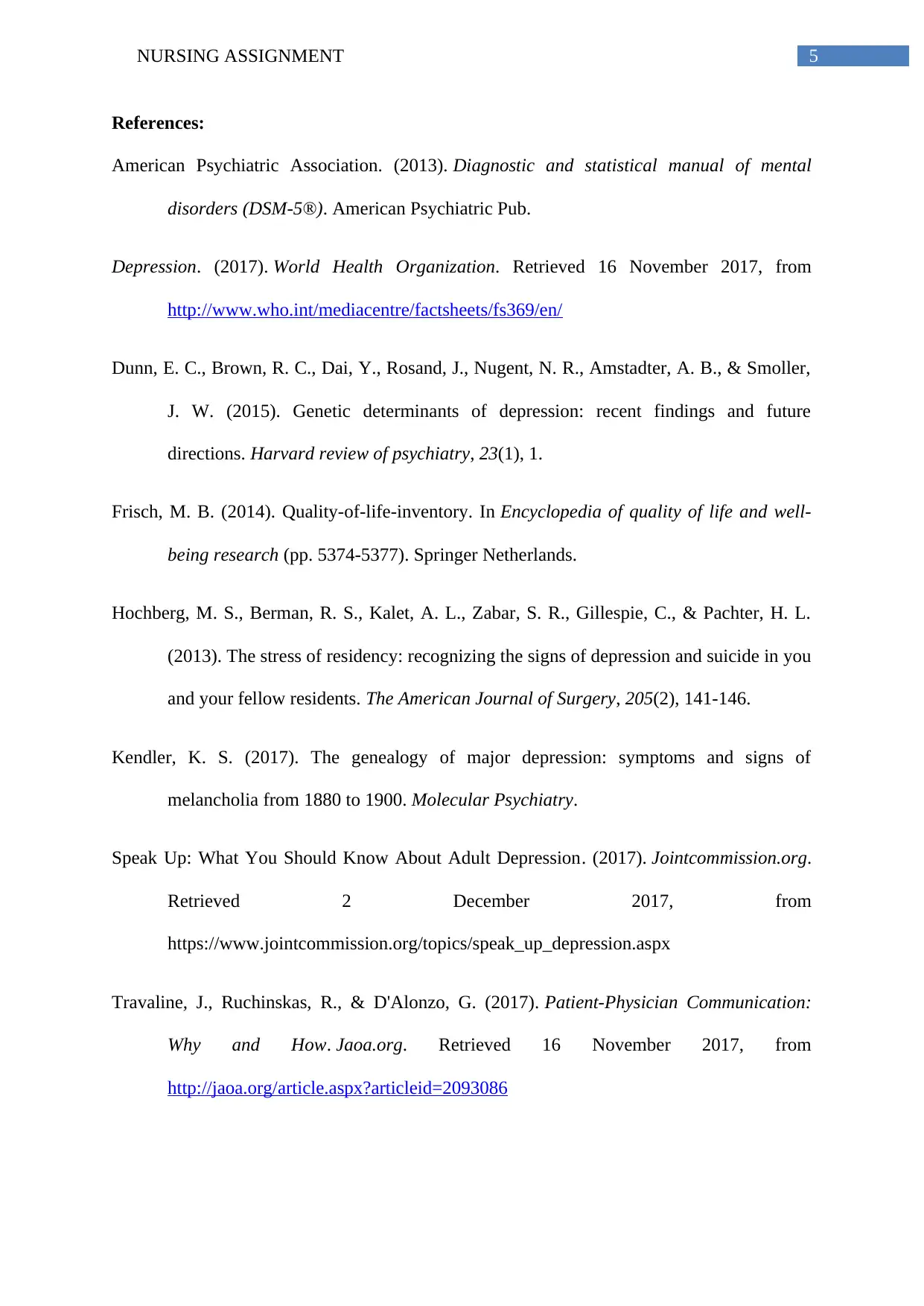
5NURSING ASSIGNMENT
References:
American Psychiatric Association. (2013). Diagnostic and statistical manual of mental
disorders (DSM-5®). American Psychiatric Pub.
Depression. (2017). World Health Organization. Retrieved 16 November 2017, from
http://www.who.int/mediacentre/factsheets/fs369/en/
Dunn, E. C., Brown, R. C., Dai, Y., Rosand, J., Nugent, N. R., Amstadter, A. B., & Smoller,
J. W. (2015). Genetic determinants of depression: recent findings and future
directions. Harvard review of psychiatry, 23(1), 1.
Frisch, M. B. (2014). Quality-of-life-inventory. In Encyclopedia of quality of life and well-
being research (pp. 5374-5377). Springer Netherlands.
Hochberg, M. S., Berman, R. S., Kalet, A. L., Zabar, S. R., Gillespie, C., & Pachter, H. L.
(2013). The stress of residency: recognizing the signs of depression and suicide in you
and your fellow residents. The American Journal of Surgery, 205(2), 141-146.
Kendler, K. S. (2017). The genealogy of major depression: symptoms and signs of
melancholia from 1880 to 1900. Molecular Psychiatry.
Speak Up: What You Should Know About Adult Depression. (2017). Jointcommission.org.
Retrieved 2 December 2017, from
https://www.jointcommission.org/topics/speak_up_depression.aspx
Travaline, J., Ruchinskas, R., & D'Alonzo, G. (2017). Patient-Physician Communication:
Why and How. Jaoa.org. Retrieved 16 November 2017, from
http://jaoa.org/article.aspx?articleid=2093086
References:
American Psychiatric Association. (2013). Diagnostic and statistical manual of mental
disorders (DSM-5®). American Psychiatric Pub.
Depression. (2017). World Health Organization. Retrieved 16 November 2017, from
http://www.who.int/mediacentre/factsheets/fs369/en/
Dunn, E. C., Brown, R. C., Dai, Y., Rosand, J., Nugent, N. R., Amstadter, A. B., & Smoller,
J. W. (2015). Genetic determinants of depression: recent findings and future
directions. Harvard review of psychiatry, 23(1), 1.
Frisch, M. B. (2014). Quality-of-life-inventory. In Encyclopedia of quality of life and well-
being research (pp. 5374-5377). Springer Netherlands.
Hochberg, M. S., Berman, R. S., Kalet, A. L., Zabar, S. R., Gillespie, C., & Pachter, H. L.
(2013). The stress of residency: recognizing the signs of depression and suicide in you
and your fellow residents. The American Journal of Surgery, 205(2), 141-146.
Kendler, K. S. (2017). The genealogy of major depression: symptoms and signs of
melancholia from 1880 to 1900. Molecular Psychiatry.
Speak Up: What You Should Know About Adult Depression. (2017). Jointcommission.org.
Retrieved 2 December 2017, from
https://www.jointcommission.org/topics/speak_up_depression.aspx
Travaline, J., Ruchinskas, R., & D'Alonzo, G. (2017). Patient-Physician Communication:
Why and How. Jaoa.org. Retrieved 16 November 2017, from
http://jaoa.org/article.aspx?articleid=2093086

6NURSING ASSIGNMENT
Williams, R. (2017). The non-designer's presentation book: Principles for effective
presentation design. Peachpit Press.
Williams, R. (2017). The non-designer's presentation book: Principles for effective
presentation design. Peachpit Press.
1 out of 7
Related Documents
Your All-in-One AI-Powered Toolkit for Academic Success.
+13062052269
info@desklib.com
Available 24*7 on WhatsApp / Email
![[object Object]](/_next/static/media/star-bottom.7253800d.svg)
Unlock your academic potential
© 2024 | Zucol Services PVT LTD | All rights reserved.





